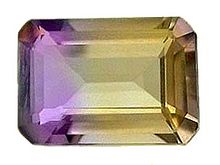Ametrine
| Ametrine | |
|---|---|
Citrine section shows very weak yellow/orange [1] | |
| Melting point | 1650±75 °C |
| Diagnostic features | Distinct segments that are purple and yellow |
| Solubility | Insoluble in common solvents |
| Common impurities | Iron |
Ametrine, also known as trystine or by its trade name as bolivianite, is a naturally occurring variety of
The colour of the zones visible within ametrine are due to differing oxidation states of iron within the crystal. The citrine segments have oxidized iron while the amethyst segments are unoxidized. The different oxidation states occur due to there being a temperature gradient across the crystal during its formation. Artificial ametrine is grown with the hydrothermal method using solutions doped with specific elements, followed by irradiation of the created crystals.[2]
Ametrine in the low price segment may stem from synthetic material. Green-yellow or golden-blue ametrine does not exist naturally.
Structure

Ametrine is composed of
History
Legend has it that ametrine was first introduced to
See also
References
- ^ "Ametrine Value, Price, and Jewelry Information". International Gem Society. Retrieved 2019-09-14.
- ^ Vladimir S. Balitsky; Taijin Lu; George R. Rossman; Irina B. Makhina; Anatolii A. Mar’in; James E. Shigley; Shane Elen; Boris A. Dorogovin. "Russian Synthetic Ametrine," Gems and Gemology, Summer 1999, p. 122-134
- ^ Vasconcelos, Paolo; Wenk, Hanz-Rudolf; Rossman, George. "The Anahí Ametrine Mine, Bolivia," Gems and Gemology, Spring 1994, p. 4-23
External links
- Ametrine at the International Colored Gemstone Association
- Ametrine: Mineral Information Page
- Ametrine: Ametrine mineral information and data
- Insider Gemologist: What Are the Identifying Characteristics of Citrine, Ametrine, Smoky Quartz, and Scapolite? Archived September 5, 2006, at the Wayback Machine
